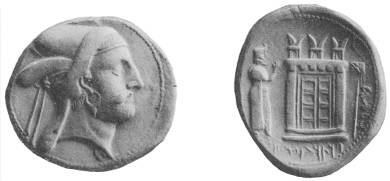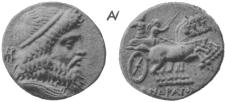
FIG. 360.



[Allotte de la Fuÿe in Corolla Numismatica, pp. 63-97, with bibliography]

After the conquest by Alexander the Great, Persis seems to have enjoyed a quasi-independence, having, at any rate, its own line of kings who were more or less subject to the Seleucid and the Parthian monarchs. Its coins are of silver (tetradrachms, drachms, &c.); obv. Head of king, rev. usually, the king before a sacred edifice or a fire-alter (Fig. 360), a type adopted by the Sassanian dynasty that overthrew its Parthian masters, circ. A.D. 228. [1] The inscriptions are in Aramaic, and the earliest coins have been assigned to Bagadates I, circ. B.C. 222(?). There are also coins of his successors, Oborzes, Artaxerxes I, Autophradates I, Darius I, Darius II, Oxathres, Artaxerxes II.
The following coins may also be noticed here, though their connexion with Persis is not certain:—
| Bearded bust r. in satrapal head-dress. Aramaic inscr. [End of fourth century B.C.] |
Quadriga r. driven by satrap whose head resembles the head on the
obv. Aramaic inscr. in ex. AV 135.9 grs.
Brit. Mus. [Head, B. M. Guide to Coins of Anc., Pl. XXVIII. 15;
N. C., 1879, Pl. I. 2.] |
The inscription has been variously read as Phahaspes, Phrataphernes, &c. Marquart (Corolla Num., p. 77) reads Vahshu Variur. The rev. is apparently suggested by a gold stater of Philip II of Macedon.
| Aramaic inscr. Head of Athena r. in helmet. | Aramaic inscr. Nike standing l. with wreath and palm. AV 132.8 grs.
Brit. Mus., from Payne Knight Coll. [N. C., 1879. Pl. I. 3.] |
1 The Sassanian coinage, mainly in silver, covers the whole period of Sassanian rule down to the Arab conquest of Persia, A.D. 651. (For bibliography see Vincent A. Smith, Catalogue of the Coins in the Indian Museum, Calcutta, Oxford, 1906, vol. i, pp. 219, 231.)
A rude imitation of a gold stater of Alexander the Great. Marquart ( l. c.) reads the rev. inscription Vahshuvar.
ANDRAGORAS.

| Bearded head r. wearing taenia (King, or Zeus?). (Fig. 361) | ΑΝΔΡΑΓΟΡΟΥ
(in ex.). Quadriga driven r. by Nike, who is accompanied by an armed warrior.
AV 131.9 grs. [B. M. C., Greek and Scythic Kings, Pl. I. 1.] |
| Female head r., wearing turreted crown. | ΑΝΔΡΑΓΟΡΟΥ
Athena standing l., holding owl, and supporting spear and shield.
AR
Attic tetradr. 255.8 grs. Brit. Mus. [Op. cit., Pl. I. 2.] |
An Andragoras was made satrap of Parthia by Alexander the Great, circ. B.C. 331 (Justin, xii. 4). Another Andragoras, satrap of Parthia for Antiochus II, Theos, was overthrown by Arsaces I, circ. B.C. 250 (Justin, xli. 4). These coins may belong to one of those satraps. (For literature see B. M. C., Parthia, p. xxx n.)